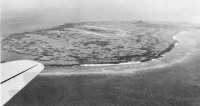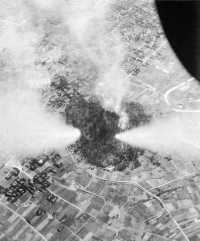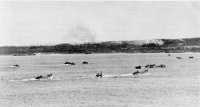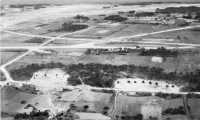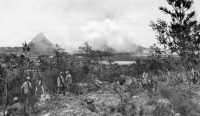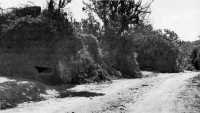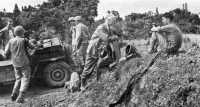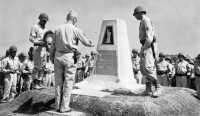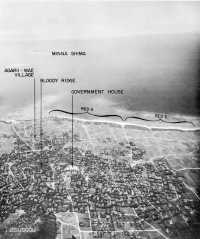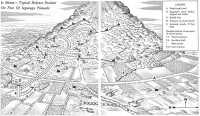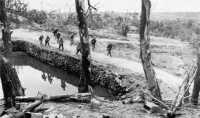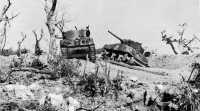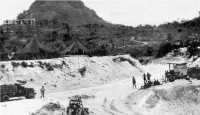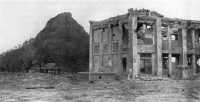Chapter 7: The Capture of Ie Shima
When III Amphibious Corps succeeded in making a rapid advance to the Motobu Peninsula and neutralizing the Japanese forces there, Tenth Army decided that early operations against Ie Shima were both feasible and desirable. Originally, both the capture of this island and the conquest of the northern part of Okinawa had been scheduled for Phase II of the campaign, but the possibility of an early seizure of Ie Shima had nevertheless been considered. On 11 April, after the successful development of operations in the north, Tenth Army merged completely Phases I and II and ordered the 77th Division to seize the island on 16 April. The main purpose of the operation was the acquisition of additional airfields to support the assault on Okinawa and the strikes against the Japanese homeland.1
Ie Shima lies about three and one-half miles off the western tip of Motobu Peninsula and twenty miles north of the Hagushi beaches on Okinawa. It is oval in shape, about five miles long and two miles wide, the longer dimension lying east and west. Coral reefs fringe the entire island. Along the north and northwest coasts the land rises abruptly in steep sea cliffs containing hundreds of caves, but along the southern shores are numerous beaches from which the terrain slopes gently upward. The best of these for landing heavy equipment, designated as Red 3 and 4 by the invading forces, lay on the southeast coast southwest of the town of Ie. The approaches were clear to the reef, the beaches were sandy and free of obstacles, and a number of roads led inland over gently rising ground. Other beaches on the southeast coast, as well as those on the south and southwest coasts, were less satisfactory because of the character of the reef and other conditions offshore, the bluffs behind the beaches, and the lack of roads.
The island is spotted with small clumps of scrub trees, sparse areas of knee-high grass, and a few cultivated fields and patches of sugar cane. Almost its
entire interior is occupied by a plateau approximately 165 feet in altitude, broken on the east by Iegusugu Mountain, which rises abruptly for about 600 feet above the level terrain and was appropriately called “the Pinnacle” by the soldiers. South of the Pinnacle lies the town of Ie, consisting of about 300 houses. Together, the plateau and the Pinnacle were the distinctive terrain features of Ie Shima and also the most important from a military point of view. Iegusugu was surrounded by clear fields of fire, and from it one could see the entire island. On the plateau the Japanese had established three landing strips, which together formed the pattern of the Roman numeral XI. No obstructions interfered with the approaches to these mile-long strips; aircraft had unlimited expanses of open water over which to gain altitude. With its pinnacle and oval plateau, Ie Shima resembled a huge, immovable aircraft carrier.2
Plans and Preparations of the Enemy
In November 1944 only the 50th Airfield Battalion was stationed on Ie Shima,3 but toward the end of the year the Japanese began to make intensive preparations for defense. The 1st Battalion, 2nd Infantry Unit, 44th Independent Mixed Brigade – called the Igawa Unit after its commander, Major Igawa – was sent back from Motobu Peninsula to Ie where it had been stationed originally. As part of the 32nd Army plan to convert members of special units into ground combat troops, the 50th Airfield Battalion, which was composed largely of veterans of Manchuria, became the 50th Specially Established Infantry Battalion. An Okinawan conscripted labor battalion, 580 strong, arrived at Ie in February 1945. The airfield battalion had originally been scheduled to return to Okinawa to work there after helping to destroy the Ie strips, but it was caught on Ie Shima by the invasion and took part in its defense.4 Likewise, only 3,000 of the 8,000 civilians were evacuated to Okinawa, Allied air attacks having destroyed nearly all the shipping in the Okinawa group of islands.
These forces, approximately 2,000 in number and aided by hundreds of civilians, spent the first quarter of 1945 fortifying Ie Shima. Expending human labor on a vast scale, they made pillboxes out of houses and tombs, honeycombed ridges and reverse slopes with trenches, tunnels, and emplacements, and concealed
Ie Shima looking east over 77th Division landing beaches, toward the Pinnacle. Marked are Green Beach 1, where the 1st and 2nd Battalions, 306th landed, , and Red 1 and Red 2, landing beaches of the 3rd and 1st Battalions, 305th, respectively
Heaviest fighting on Ie Shima took place on the eastern end of the island (below), where the town of Ie can be seen between southern beaches and the Pinnacle
rifle pits and machine-gun and mortar positions in hedgerows. The numerous natural caves were strengthened by tunnels and holes dug into the limestone rock. Some caves were three stories deep and had outlets for firing positions on each level. Mortar emplacements were made twenty feet deep; cave mouths were fitted with sliding steel doors.5
Early in March the Japanese command on Okinawa, believing that Ie Shima could not be held for more than a few days, ordered that all airfields on the island be destroyed by the end of the month because of tactical requirements.6 Thorough demolitions followed. The runways were ditched and blasted and the entire central area sown with mines, as defense against possible airborne attack. The enemy showed his usual resourcefulness; the mines included bombs rigged variously as pressure-detonating or controlled charges, wood and terra cotta antitank and antipersonnel charges, and fougasse mines made from drums of gasoline.
The Japanese defense plan was based on an elaborate attempt to trick the Americans. The defensive positions were concentrated in and around the town and the Pinnacle because the terrain and the structures there were well adapted for fortification. Consequently, the central east sector of Ie became by far the strongest area; the western part of the island was merely outposted and mined. Furthermore, the best landing beaches were near the southeast end of the island and were commanded by the strong positions in the Ie–Iegusugu area. The Japanese hoped to lure the invaders in over these exposed southeastern beaches and then to destroy them by intense fire from hundreds of concealed positions in the Pinnacle and the town of Ie. They tried to deceive the Americans into thinking that the good southeastern beaches were not defended while the poorer beaches were heavily defended; if the ruse succeeded and the Americans landed on the southeast, the Japanese could exact a heavy price. Consequently, when American reconnaissance parties operated off the southeastern beaches, they were not fired on and could see no indication of the enemy; one American actually strolled along the beach without drawing fire. Pilots flying 100 feet over the area saw no sign of activity. But on the less desirable southern and southwestern beaches the situation was reversed. Here, in accordance with the Japanese strategem, beach reconnaissance parties drew considerable small-arms fire from the shore.7
American Plans and Preparations
The ruse failed. The 77th Division staff relied on photo interpretation and map study, which provided an accurate means of plotting the development of defensive installations on Ie. After studying photo intelligence reports of 1 March, the G-2 of the 77th stated on 15 March that the nature of the defenses on Ie made a landing on the southeast undesirable, since such a landing would encounter maximum initial resistance:–
Therefore, from a consideration of both terrain and enemy action, a landing over the beaches on the southwest end of the island should meet with the greatest initial success. An attack from the west enters the back door of the defensive organization east of the airport. However, the capture of key terrain and the best beaches for bringing in heavy equipment will be delayed.8
Plan of Attack
This analysis set the pattern of the attack. General Bruce, in a field order issued 12 April 1945, ordered the 305th Regimental Combat Team (RCT) to land on Red 1 and 2 on the south coast of Ie Shima on 16 April and the 306th RCT to invade Ie simultaneously over Green Beach at the southwest end of the island. While the 305th advanced eastward to seize additional landing beaches, the 306th was to swing around on the 305th’s left (north) flank and overrun the airfield. Together the two regiments would reduce the strong points at the eastern end of the island. The troops would be supported by the 105-mm. howitzers of the 305th and 902nd Field Artillery Battalions and by the 155-mm. guns of the 306th, which on the day before the landing were to be emplaced on Minna Shima, a sand islet four miles south of Ie.9 (See Map 19.)
This plan was adopted over the objections of supply officers of the 77th, who pointed out that reef conditions off the selected beaches would prevent the use of landing craft except for a short time at high tide. The surfaces of the wide coral reef offshore were so rough and broken that nothing but LVTs and DUKW’s could negotiate them.10 It was planned, however, to unload only a minimum of supplies over these beaches and to unload the heavy equipment over the more desirable beaches farther east-Red 3 and 4-once they had been secured by the 305th RCT.11
Although the Japanese failed to lure the invaders onto the best-defended beaches, they did succeed, through excellent camouflage, in concealing their strength on Ie. During early April the 77th received a series of reports from air observers which indicated that Ie was almost deserted. On 6 April General Bruce, explaining his plan to General Buckner, wrote as follows:
... original estimate of enemy is considerably reduced. It is planned to take entire division to target area; secure island quickly with minimum forces, less heavy equipment. ... This plan places sufficient forces in immediate target to quickly and unquestionably complete mission with minimum casualties.12
Actually, the entire division was not available to General Bruce. The 2nd Battalion of the 305th Infantry was garrisoning the Kerama Islands. The 307th RCT was being held in readiness by Tenth Army to feint a landing on the southern beaches of Okinawa in connection with an attack planned for 19 April. All but the 1st BLT of the 307th, however, was made available to General Bruce during the operation. The 77th had suffered some casualties in the Keramas, but the number was doubled by Kamikaze attacks on division shipping during the early part of April. On 2 April, during a night retirement, the 77th Division convoy was caught twelve miles south of Kerama Retto by a flight of Japanese suicide planes which attacked from the clouds. Four ships were crash-dived before fighters and antiaircraft drove off the enemy craft.13
Preparations for the Assault
In preparation for the landings, units of the Fifth Fleet bombarded Ie Shima intermittently from 25 March through 16 April. Systematic bombardment of the island began on 13 April when the battleship Texas, two cruisers, and four destroyers fired on targets throughout the island, concentrating on the strong points in the east. That evening six rocket LSMs began a night interdiction and harassing patrol of Ie, firing rockets and 40-mm. shells and executing illuminating missions. A similar schedule was followed on the 14th; on the 15th the daylight bombardment of Ie was canceled to prepare for other required dispositions of the fire support ships.14
During the first ten days of April, Navy fighters and light bombers attacked caves, buildings, and installations on Ie Shima. After a spell of bad weather from 10 to 12 April, the air strikes were intensified. During the period 13-15 April
Rockets over Ie Shima, fired by a Navy airplane toward the Pinnacle. Beyond, to the south, are Ie and Government House, almost obscured by smoke of preinvasion softening-up. Dark area (upper right) is nose of plane
54 strikes comprising 292 sorties were flown; 830 rockets, 35 tons of bombs, and full loads of .50-caliber ammunition struck all targets that could be located by observation and by study of aerial photographs. All remaining emplacements around Ie were neutralized and two aircraft found on the field were destroyed.
Under the cover afforded by these air and surface strikes, Navy underwater demolition teams conducted daylight reconnaissance of all beaches on Ie during 13 and 14 April. Except for light and inaccurate enemy fire on the western beaches, the swimmers met no opposition. The teams provided the earliest firsthand information on Ie ; although their observations were made from the water line, their reports on beaches and terrain immediately inland proved to be accurate.
On the night of 12-13 April the Amphibious Reconnaissance Battalion of the Fleet Marine Force, Pacific, landed on Minna Island and secured it without resistance. On 15 April, the 305th, 902nd, and 306th Field Artillery Battalions went into position on Minna to support the Ie operations. Each battalion quickly registered on base points and check points established on the target. Three cub planes, operating from a field constructed within a few hours after the landing, conducted registration missions for the battalions. There were no preparatory or neutralizing fires, however, until the attack began on the following day.15
It had been the enemy’s original plan to cover Ie Shima with his own artillery on Okinawa. During the operations on Motobu the marines overran a battery of two 150-mm guns, complete with prime movers and ammunition, near the west coast of the peninsula. The guns were in a steep draw which opened directly toward Ie Shima. They were to be fired from the mouths of caves and to be pulled back when not in use. Late in March, General Ushijima had ordered the naval detachment in charge of the guns to prevent American use of the airfields on Ie; the two guns completely covered the island.16 By the time of the invasion of Ie, the situation had been neatly reversed; the enemy had lost his guns, and Ie Shima was exposed to American medium and heavy land artillery as well as to the powerful guns of the Pacific Fleet.
Invasion of Ie Shima, 16-17 April
Two battleships, four cruisers, and seven destroyers of the Fifth Fleet opened up a heavy bombardment of Ie Shima at dawn of 16 April. LCIs swept the
landing beaches with rockets and mortar shells. Thousands of rounds of 40-mm., 20-mm., and .50-caliber ammunition arched into the beaches from support craft and from guide boats escorting the first landing waves. Planes bombed and rocketed the island and dropped tanks of napalm on and behind the beaches. Billowing clouds of smoke and dust rose from the flaming napalm, exploding ammunition dumps, and burning gasoline stores. Within a few minutes Ie Shima was blacked out. Puffs of white smoke against the gray pall over the island showed where the rocket and mortar ships were preparing the beaches. A Japanese soldier wrote in his diary: “After fierce air and naval bombardment, the enemy began his landing in front of the 4th Company, using amphibian tractors. Their fire power is so great we dared not show our heads.”17
Debarkation of the landing craft from the LSTs went smoothly. By 0650 boat waves were forming in the assembly area. Soon afterward amphibian tanks, followed by waves of amphibian tractors, roared toward the landing beaches from the line of departure 3,600 yards offshore. The weather was clear and bright and the sea was calm. The tanks and tractors moved past the cruisers, destroyers, and LCIs to the smoking beaches. As the first waves neared the shore, support fire was directed inland.18
At 0758 – two minutes ahead of schedule – the forward elements of the 1st BLT of the 305th landed on the southern coast of Ie directly south of the airfield. Three minutes later the 3rd BLT of the 305th started landing on a separate beach 600 yards to the left (west). The troops pushed rapidly inland over high dunes. On reaching a road which ran along high ground 400 yards north of the beaches, the 1st Battalion swung east. From this high ground to the town of Ie there were extensive mine fields which, although hurriedly laid and crudely camouflaged, slowed the movement of amphibian tanks and self-propelled guns. The 3rd BLT moved inland and then swung east toward Ie, its left flank passing just south of the easternmost air strip.
At 0807 the first waves of the 306th RCT landed on a 600-yard-wide beach at the southwest end of Ie, with the 1st BLT on the left (north). Within three
Invasion of Ie Shima was well prepared but met considerable opposition. Assault boats approach the island as supporting shell fire is lifted from the beaches and moved inland
Eight hundred yards inland from Red Beach 2 were these cave positions, around which the 305th RCT, 77th Division, was engaged in an infantry-demolition fight until nightfall of 16 April
hours the assault battalions advanced 2,000 yards inland to the western edges of the airfield. The 3rd BLT of the 306th completed its landing at ioi5 and, as the reserve battalion, patrolled the western end of the island. After mopping up small groups of Japanese in caves and entrenchments, the 3rd BLT resumed its advance to the east, echeloned to the left rear of the 1st BLT of the 306th.
The rapid advance of the 306th continued during the afternoon of the 16th. The troops quickly overran the airfield. Although the open, level expanse of the runways offered clear fields of fire for the defenders, the only opposition came at the east end of the airfield, where American troops and amtracks knocked out several pillboxes. After pushing on regardless of phase lines, in accordance with division orders, the 306th Infantry by nightfall had gained 5,5oo yards for the day and had overrun about two-thirds of the length of the island which lay in its zone of action. The 306th, with three battalions abreast, held a line which began at a point just north of Ie, about 600 yards from the base of Iegusugu, and ran northwest to the north coast. The 306th advanced so rapidly during the day that a gap developed between its right (south) and the left (north) flank of the 305th. To cover this area by fire and prevent attack from the east, Company K of the 306th took a position on three Japanese-built bunkers about 300 yards east of the airfield.
Slow Progress on the South Coast
After advancing inland and wheeling to the east in the morning, the 305th RCT attacked east in a zone parallel to the coast, extending about 800 yards inland. Progress during the afternoon was slow. The enemy delivered rifle and machine-gun fire from coral emplacements west of the town of Ie and from caves and fortified tombs in the hillside below the plateau. It was mainly an infantry-engineer fight; armor and self-propelled guns were held up by mines, including many buried 500-pound aerial bombs. By nightfall the 1st Battalion had advanced only 800 yards from its beachhead; the 3rd Battalion, which made the wide turn on the left of the regiment, had moved about 1,800 yards.
During the night of 16 April the enemy launched a coordinated attack on the 3rd Battalion of the 305th. The attack came with suicidal recklessness. The Japanese were supported by mortars and 70-mm. guns, and were armed with small arms, sharpened stakes, bags of hand grenades, and literally hundreds of satchel charges, some of which had been improvised from mortar shells. Japanese worked up to the perimeters in small groups and either threw their satchel charges at close range or blew themselves up in an effort to take Americans with them. Some of the human bombs were successful, but most of the
Japanese were killed before they came within effective range. One American had his arm broken by the flying leg of a Japanese soldier who had blown himself up. After hours of wild fighting in the dark the enemy withdrew, leaving 152 of his dead in and around the 3rd Battalion’s position. Meanwhile the 1st Battalion of the 305th RCT fought off a number of small harassing attacks, but the 306th had a relatively quiet night.
The next day, 17 April, the 305th resumed its attack in an attempt to seize the high ground behind Red Beaches 3 and 4. Following preparations by the two light artillery battalions on Minna Shima and by one light battalion which had landed on Ie, the 1st and 3rd Battalions pushed off to the east. Apparently the enemy had concentrated his defenses in front of the 3rd Battalion sector, for the 1st Battalion, moving along the coast, met only scattered opposition and made substantial gains during the morning. By noon the 1st Battalion had advanced another 800 yards and had partially secured the area behind Red Beaches 3 and 4.
The 3rd Battalion of the 305th quickly seized high ground in its sector, about 800 yards short of the town, after a brief fire fight during which Lt. Col. Edward Chalgren, Jr., the battalion commander, was wounded. The attack was slowed down by heavy machine-gun fire coming from caves in the coral slopes on the left (north) side of the regiment’s zone of action. A flanking movement followed by infantry-tank action reduced this enemy position, and the advance continued. Although intermittent mortar, rifle, and machine-gun fire made progress of the troops during the rest of the morning slow, by 1245 the 3rd Battalion had generally secured the ground behind the central beaches and had reached the immediate outskirts of Ie.
During the 17th the 306th Infantry held its lines in place to enable the 305th to come abreast and to assist its advance by fire. The regiment probed the enemy’s defenses around Iegusugu with combat patrols. The enemy appeared to have anchored his right (north) flank on Iegusugu and to have extended his line generally southeast to the coast. His strongest defenses seemed to lie south of the Pinnacle in Ie town; his defense in depth here was holding the 305th to small gains.
Entrance of the 307th Infantry
When the 305th met increasing resistance on 16 April, General Bruce decided to commit the 307th Infantry on the beaches southwest of Ie. Several considerations underlay this decision-one of them the supply situation. The whole plan of attack assumed that the superior beaches to the east of the 305th’s
Fighting toward Ie, American troops were held up close to the town by strong Japanese positions. The morning of 17 April the 305th Infantry, 77th Division, paused while artillery pounded Japanese positions in the western outskirts (smoke-covered area)
At the same time the right flank of the 305th was attempting to reduce these enemy pillboxes along the road parallel to Red Beaches 3 and 4
landing beaches would be seized quickly in order to land tanks and other heavy equipment. Moreover, with the capture of the airfield the first day it was advisable to land heavy aviation engineering equipment as soon as possible. General Bruce’s main reason for committing the 307th, however, was his desire to capture the island as quickly as possible. Reports indicated that about 1,000 of the enemy had withdrawn to the Pinnacle area for a last stand. General Bruce knew that the 307th might be available to him for only a day or two, being scheduled to make a demonstration off the beaches at the southern end of Okinawa on 19 April. At 1615 on 16 April, General Bruce asked General Buckner for two assault battalions of the 307th, promising to return them by noon of the 18th “or earlier” if they were needed for the demonstration. General Buckner assented.
The 2nd and 3rd Battalions of the 307th landed on the beaches southwest of Ie during the morning of 17 April, with the 3rd Battalion on the east. The plan called for these two battalions to attack abreast northeast toward Ie. They were to pass through the 1st Battalion of the 305th Infantry, which was holding the ground inland to the west of the two beaches over which the 307th landed. The attack was to cut across the front of the 3rd Battalion of the 305th, which would provide supporting fire from its flank position on the outskirts of Ie.
The 307th jumped off at 1300. Both battalions made about 400 yards in two hours against steadily increasing resistance. The troops had to move uphill over open ground. From his positions on the Pinnacle and on intervening high ground, the enemy had perfect observation of their movements. The strongest Japanese positions, aside from those in or around the Pinnacle, were along a prominent ridge and in a small rise on the ridge topped by a large concrete building, about 700 yards southwest of Iegusugu. These positions came to be known as “Bloody Ridge” and “Government House Hill.”
The 307th made limited gains during the afternoon of 17 April. In the town the 3rd Battalion came up against an organized position protected by wire entanglements and mines. A house-to-house fight ensued. The mined and debris filled streets prevented the self-propelled guns from coming up in support; when engineers tried to clear the way, the enemy opened up on them with machine guns. The 3rd Battalion moved east several hundred yards along gently sloping ground south of the town.
By late afternoon both battalions were receiving heavy mortar and small arms fire from dominating ground ahead of them. The numerous mine fields slowed the movement of self-propelled artillery, and since tanks had not yet
been landed the foot soldiers and the engineers bore the brunt of the close-in action. Division artillery kept the rear enemy areas under attack. Elements of the 307th fought their way to a point 600 yards south of Government House Hill, but, being unable to consolidate their position for the night so close to Bloody Ridge, they withdrew to more favorable terrain about 400 yards inland from the beach. Casualties were mounting. Hopes for a quick victory were fading.
Stalemate at Bloody Ridge, 18-19 April
After receiving an urgent request from the assistant division commander, Brig. Gen. Edwin H. Randle, for retention of the 307th RCT on Ie Shima to avoid serious delay in its capture, General Bruce secured permission from Tenth Army to keep the regiment. The plan for 18 April called for continuation of the attack by the 307th, supported by the 305th, against the defense in depth established by the enemy in the town south of the Pinnacle. The 306th Infantry, pivoting on its right (south) flank, was to attack toward. the Pinnacle from the west and north. Although this move would continue the encirclement of the enemy’s main positions around Iegusugu, the main effort was to be the attack from the south and west. For two days the 305th and 307th were to batter in vain against Bloody Ridge south of the Pinnacle. In the fierce fighting south and west of the Pinnacle during 18 and 19 April, the 77th Division was to meet the stiffest opposition in its experience and to sustain the bulk of its casualties on Ie Shima.
The enemy detachments concealed behind American lines had tragic consequences for Ernie Pyle, war correspondent, as well as for many troops of the 77th. On 18 April Pyle was on his way to the front in a jeep, accompanied by a regimental commander. At the outskirts of Ie, a Japanese machine gun hidden in the terraced coral slopes along the side of the road sent both men into a ditch for cover. When Pyle raised his head a few moments later, another burst caught him full in the temple just below the rim of his helmet, killing him instantly. Only after three hours of intense patrol action was the enemy position destroyed. Pyle was buried in the 77th Division’s cemetery on Ie under a crude marker which the Division later replaced by a monument. The inscription reads: “At this spot the 77th Infantry Division lost a buddy, Ernie Pyle,. 18 April 1945.”
Attack of 28 April
The 306th Infantry moved out at 0730 on 18 April and the 307th an hour later. The ad Battalion of the 306th on the right (south) and the 3rd Battalion
on the left met initially little opposition as they pushed generally east in their zones of action north of Iegusugu. The 307th Infantry, however, met heavy resistance from the beginning. From the rubble of Ie and from positions dug into Bloody Ridge the enemy fought back with heavy mortar, machine-gun, and rifle fire. Infantrymen, closely backed by engineer blasting teams, often had to fight their way into the enemy positions and clean them out with grenades and bayonets. (See Map 20.)
The 2nd Battalion, 307th, had especially hard going, for it was moving directly into the strongest enemy positions on Bloody Ridge. At first it was planned that the 3rd Battalion of the 305th would follow the ad of the 307th and take over the attack, and the 3rd actually moved to a position behind it. Resistance was so strong, however, that the plan was altered; the 3rd Battalion was recalled and sent in on the left (north) of the 307th to attack east toward Iegusugu. The battalion was also to maintain contact with the 306th, which was swinging around north of the Pinnacle.
After a heavy preparation by the artillery on Minna Shima, the 3rd Battalion, 305th, attacked at 1130 on an 800-yard front. A house-to-house fight ensued amid the rubble of Ie. “Every street became a phase line,” one observer reported.19 The necessity of forming a connecting link over the wide area between the 306th and the 307th made the fight harder. Artillery was ineffective against many enemy positions and could not be used freely because other friendly units were so close by. Self-propelled guns were held up by mines and debris in the narrow streets. After working about halfway through the northwestern section of the town, the troops withdrew to a more secure position on the outskirts, their right (south) flank then being 500 yards west of Government House Hill, and their left (north) flank 100 yards west of the base of Iegusugu. They had made a net gain of only about 350 yards for the day.
When the attack of the 307th came almost to a standstill directly south of Government House Hill about midday of 18 April, it was decided to send the 3rd Battalion of the 307th around to the right, where it could attack toward the northeast in the eastern section of the town. The Americans hoped that resistance east of Government House Hill would be less severe than that encountered south of it, and such proved to be the case. The 3rd Battalion made moderate progress and advanced to a point 300 yards north of the village Agarii-mae. Medium tanks and self-propelled guns covered the gap that developed between
Death of Ernie Pyle, American war correspondent, took place while he was observing the fighting on Ie Shima. Above he is pictured talking to a Marine infantryman on Okinawa a few hours after its invasion
After the close of the Ryukyus campaign Brig. Gen. Edwin R. Randle, assistant commander of the 77th Division, unveiled a monument (below) over Pyle’s grave
Ie and the southern beaches viewed from directly over the Pinnacle
the two battalions of the 307th. These weapons put direct fire into caves, pillboxes, and enemy gun positions in the town of Ie and the Pinnacle. They could not be moved close to the enemy positions, however; deadly machine-gun and mortar fire held the infantry back and left the armor vulnerable to suicide attacks by Japanese armed with satchel charges, who hid in holes until the tanks and guns came within range.
In order to protect the right (southeast) flank of the 307th Infantry, the 1st Battalion, 305th, moved into position on the right of the 3rd Battalion, 307th. The 1st Battalion, having passed to the control of the 307th at 1500 on 18 April, attacked to the north abreast of it, covering a zone from the flank position of the 307th to the beach. Meeting little more than scattered sniper fire, forward elements had moved about 1,000 yards by the end of the day. This battalion had advanced farther than the 307th, however, and in order to protect the latter’s right (east) flank it withdrew to a position about 600 yards east of the village of Agarii-mae.
In its advance north of Iegusugu the 306th made good progress during the day, despite almost continual mortar fire from positions on the Pinnacle from which the enemy had unlimited observation of all movements. The regiment pivoted on the ad Battalion, which in its attack toward the base of the Pinnacle had by the end of the day occupied positions as close as 300 yards to its base on the northwest side. In the center of the regimental zone the 1st Battalion encountered four pillboxes, which were finally reduced by hand-placed charges. The 3rd Battalion, moving along the north coast, reduced enemy positions in caves in the bluffs after hours of fighting at close range. The 306th could have pressed farther east against scattered groups of the enemy, but instructions were received to cease advance in order to avoid fire which was supporting the 305th and 307th Regiments. By the end of the day the line of the 306th extended from the northeast base of Iegusugu to the northeast coast of the island.
Crisis at the Beaches
Meanwhile a crisis had developed at the beaches. From the very beginning of the operation supplies for the troops on Ie Shima had been a touch-and-go affair. As had been expected, the initial assault beaches were suitable only for DUKW’s, LVTs, and small boats, and even then for only a few hours at high tide. The superior beaches southwest of the town of Ie,-Red 3 and 4, were not secured on the 16th as planned; reconnaissance parties were driven off by heavy enemy fire. It was only after the 307th landed on Red 3 and 4 on 17 April that unloading of heavy equipment could be undertaken. The first cargo was not
Ie Shima. Typical Defense Position On Face of Iegusugu Pinnacle
This diagram of a typical defense system on the face of Iegusugu Pinnacle was adapted from a sketch appearing in CINCPAC-CINCPOA Weekly Intelligence, Volume 2, Number 5, 13 August 1945. The diagram does not show all the defensive positions in the area depicted and is designed only to indicate the method by which the enemy attained mobility even in fighting from positions underground. In describing this position the bulletin states:
About 50 yards south of the approach road was the camouflaged entrance to a typical tunnel system within the hill. The entrance was a square log-shored shaft 30 feet deep. A smaller curved shaft which came to the surface about 15 feet away was probably designed for ventilation purposes. The main tunnel to the hill installations ran from this shaft, under the road to the first of a series of caves approximately 100 feet from the shaft entrance. this tunnel was from four to five feet high and three feet wide . Walls were reinforced with logs six to eight inches in diameter, Loose coral rock on the ceilings was held in place by logs. The tunnel apparently was used for ammunition storage as well as communication.
Image merged onto previous page
on shore until the evening of 17 April. For the first two days of the operation the supply level maintained by the shore parties was only barely adequate.20
The difficulties were by no means over when Red 3 and 4 were captured. From his positions in Ie, on Bloody Ridge, and on the Pinnacle, the enemy could put mortar fire on the beaches to the south and on the area directly behind them. During the night of 17-18 April numerous enemy infiltration attempts supported by mortar and machine-gun fire had to be repulsed by shore party engineers. On the 18th the enemy seriously delayed the organization of the beach by firing on the exit roads. The beach became congested with supplies. A platoon of the 233rd Engineers had to abandon its shore duties and clear a proposed dump area of snipers who were harassing unloading operations. Late on the 18th unloading was temporarily halted because of the enemy fire. The building up of adequate supply levels was again delayed.
Not until 21 April was the eastern exit free of Japanese fire. In the meantime shore parties continued to improve the beach, establish water-supply points, land tanks and other heavy equipment, and move supplies to beach dumps. Although superior to the other beaches, Red 4 was far from ideal. The deep sand made it necessary for tractors and bulldozers to tow in wheeled vehicles. Until two causeway sets were established on 20 April, LSTs had to come in through a narrow, crooked channel, and there were many vexing delays. Unloading schedules were also disrupted when sudden squalls arose and when frequent Kamikaze attacks forced ships to disperse and maneuver.
Heavy expenditures of ammunition by artillery, tanks, and self-propelled mounts (SPMs) as they hammered at strong positions on Ie necessitated selective unloading of ships; considerable cargo had to be moved in the holds of ships to get at the ammunition reserves. Despite temporary shortages, however, the combat troops received the needed supplies. By 24 April, the 77th Division shore party, in addition to supplying the division, had unloaded 14 LSTs carrying 18,331 measurement tons.
Reversal at Bloody Ridge, 29 April
On 19 April, as on the two previous days, the plan called for the main effort to be directed against the strongest Japanese positions on Bloody Ridge in an attack by the 305th and 307th from the southwest. No attack was ordered for the 306th because any advance might bring it under naval gunfire supporting the
main attack; the lines of the 306th would remain substantially unchanged for the day.
The continuation of this attack after failure on the two preceding days was due largely to the critical situation at the beaches; American forces were attacking toward Bloody Ridge and the Pinnacle, with Red Beaches 3 and 4 a few hundred yards to the south. The protection of these beaches was the decisive element of the tactical plan. The rapid establishment of Ie airfield was highly important in the strategic concept of the Ryukyus campaign, and equipment for the airfield, as well as for a badly needed air warning service, was coming in over these exposed beaches. General Bruce stated in a message to General Buckner: “I know emergency exists for air warning service and airfields. My tactical plans for 17, 18, 19 April based on necessity of securing Red Beaches 3 and 4 for unloading garrison troops even though not required for my supplies and even though other ground maneuver would have been preferable.” General Bruce believed that the enemy might stage a banzai attack on the vital beach area if only a holding force were left south of Bloody Ridge while the main thrust was delivered against the Japanese from a different direction.21 (See Map No.21.)
After a half-hour artillery preparation, three battalions attacked at 0900 on 19 April. The 3rd Battalion, 305th Infantry, moved east against the northern part of Ie; the 2nd and 3rd Battalions, 307th, attacked north from their positions south of Bloody Ridge, moving abreast with the 3rd Battalion on the east. By massing all the 8i-mm. mortars and heavy machine guns of its ad and 3rd Battalions and those of the 1st Battalion, 305th, the 307th built up a heavy base of fire for the advancing assault troops. The infantrymen along the line fought their way from one strong point to another in a series of bloody skirmishes marked by hand-to-hand combat. From the high ground the enemy poured mortar and small-arms fire on the troops; there seemed to be more of it than ever. The controlling factors on the 19th were the same as on the 17th and 18th-heavy and accurate enemy fire from all the high ground and especially from Bloody Ridge; the ineffectiveness of artillery against many of the Japanese positions; and the restricted use of self-propelled artillery because of the rough terrain, the narrow roads, and numerous mines.
Once again some progress was made on the east flank, less on the west, and practically none in the center. On the east the 3rd Battalion of the 307th, bypassing the main enemy positions to the west, managed to advance 800 yards north. A
gap thereby developed between the two battalions of the 307th, and to fill it the 1st Battalion, 305th, pulled out of its position north of Agarii-mae, swung south and west, and attacked north at 1330.
The 3rd Battalion of the 305th Infantry, on the west, ran into heavy fire from pillboxes and the ruins of Ie as it pressed east. Since the battalion was to maintain contact with the 307th on the right (south) and the 306th on the left (north), its commander had to extend his line into parallel zones of advance, with platoons taking a street apiece. In the maze of smashed buildings and rubble, fields of fire averaged only from 10 to 20 feet. Because of the width of the front and the channelized fighting, the unit could not mass its strength for a drive in any one zone. The battalion gained about 250 yards, lost 100 yards on the right in a Japanese counterattack, and then withdrew to the outskirts of Ie for a safer night position.
Companies F and G of the ad Battalion of the 307th, in the center, attacked at 0900 and slowly fought their way up the slopes of Government House Hill. After a frontal attack had failed because of heavy enemy fire, the two companies turned to the west, pushed into the edge of the town on the high ground, and then swung back to the nose of the ridge and proceeded to assault the large buildings there during the afternoon. Meanwhile the 1st Battalion, 305th, on the east flank of the ad Battalion, 307th, had attacked through heavy fire at 1330 and had reached high ground 300 yards east of Government House Hill.
Two battalions were now on Bloody Ridge, but they were not to stay for long. An enemy counterattack supported by mortar and automatic fire drove the men of the 1st Battalion, 305th, off the high ground and back to their original position near the beach. At this time the ad Battalion, 307th, was still fighting for Government House Hill 300 yards to the west. The Americans could not, however, consolidate their hold on the buildings. Their ammunition was running low; an amtrack started up the hill with resupply, but the drivers fled when a group of Japanese ran out of a small draw and flung a satchel charge into the vehicle. The troops on the hill were now receiving fire from the high ground just lost by the 305th as well as from the area to the north. Their commander received permission to withdraw. Despite intense fire, Pfc. Martin O. May, a machine gunner of Company H, voluntarily held his post and covered the withdrawal. Another assault on Bloody Ridge had netted only heavy casualties.
The Japanese on Ie Shima were using the defensive methods that had characterized their fighting on other Pacific islands: a house-to-house, cave-to-cave, yard-by-yard linear defense, supported by vicious counterattacks of from platoon
to company strength; ingeniously concealed detachments that harassed rear elements after the assault troops had passed by; and night infiltrators who even reactivated mines that had been collected by American troops during the day. Although they had few heavy weapons on Ie, the Japanese effectively used mortars, antitank guns, and light and heavy machine guns; when these were not available, they fought with satchel charges, grenades, and crude spears. The soldiers on Ie, unlike those on Kerama, had the fanatical support of the civilians, including even women with babies, who took part in suicide raids and helped defend caves and tunnels.
On Ie Shima the Japanese sowed thousands of mines, most of them on the airfield, along the beaches and beach roads, and in the heavily defended area west of the town of Ie. Many mines were adapted from aerial bombs and set up in a crude manner: the bomb was fixed at the bottom of a hole, fuse up, and a rock was balanced on two poles at the top of the hole. A pull wire ran from one of the poles to a Japanese soldier concealed nearby who set off the contraption when an American vehicle approached. Such a bomb-mine could flip a 15-ton amtrack over on its back. Most of the mines, however, were of a more standard type.
Capture of Iegusugu, 20-21 April
General Bruce determined to break the deadlock. On 19 April he reconnoitered the eastern approaches to Iegusugu by sailing around the eastern end of Ie Shima in a Navy control boat. Aerial reconnaissance had failed to give an accurate picture of the terrain, but from his floating observation post General Bruce was able to study the terrain as it would appear to attacking infantrymen. He concluded that the most promising direction for the attack on Iegusugu would be across the favorable terrain north and east of the Pinnacle. His plan of attack for 20 April shifted the main effort from the 307th Infantry, south of the Pinnacle, to the 306th, north of it, while the division as a whole tightened the ring around Iegusugu. (See Map 22.)
By nightfall of 19 April the regiments of the 77th were in an advantageous position to execute this plan. The lines of the 306th Infantry extended from the Pinnacle northeast to the coast, and the 306th had patrolled extensively southeast of its lines. After its easy advance on 19 April, the 3rd Battalion of the 307th was directly at the base of Iegusugu on the east. South and west of the mountain and the town were the battalions that had been hammering at Bloody Ridge: from southeast to west, the 1st Battalion, 305th; the 2nd Battalion, 307th; and the 3rd
Attack on Bloody Ridge of 20 April was marked by severe fighting. Infantrymen of the 307th infantry, 77th Division (above), move on the double toward Government House Hill, on the ridge
During the fighting on Bloody Ridge two medium tanks (below) were knocked out by Japanese artillery fire from the Pinnacle
Battalion, 305th. Since the noose around the enemy bastion was not yet tight, the 2nd Battalion, 307th, and the 1st Battalion, 305th, were ordered to recapture the ground they had lost on the previous day, while the 306th made the main assault from the northeast.
Closing the Ring
At 0850 an 20 April artillery fired an intense preparation on enemy-held areas ahead of the troops. At 0900 the fires stopped. For ten minutes, as part of a stratagem to draw the Japanese out of their position, the infantry remained in place. Then at 0910 the artillery loosed an even heavier concentration, lasting fifteen minutes.
The three regiments attacked on the heels of the second bombardment. The 306th jumped off with the 1st Battalion in assault, supported by tanks and combat engineers. The 2nd Battalion of the 306th remained in position on the north slopes of the Pinnacle, and the 3rd Battalion followed the 1st, echeloned to the left (southeast) of the 1st to protect its flank. The 3rd Battalion of the 307th, east of Iegusugu, pulled back to the south to give the attacking troops greater freedom of action. The 2nd Battalion of the 307th, with the 1st Battalion of the 305th abreast of it on the east, again drove up the steep slopes toward the top of Bloody Ridge and the town and mountain beyond. The 3rd Battalion, 305th, attacked east into Ie--for the fourth consecutive day.
All the assault units closing in on the Japanese came almost immediately under heavy fire. Enemy resistance seemed no less stubborn than on the previous days. The 305th and 307th, respectively south and west of the town of Ie, were soon involved in another bitter, yard-by-yard advance. Once again the 3rd Battalion, 305th, had to fight through a maze of rubble and narrow streets amid the ruins of Ie. Under intense mortar and small-arms fire, the 2nd Battalion, 307th, and the 1st Battalion, 305th, pushed up once again toward the top of Bloody Ridge, the key to the enemy’s defenses south of the Pinnacle. The two battalions moved out across open terrain dominated by the enemy, who had perfect observation of all their movements.
Leading elements of the 306th came under intense mortar and small-arms fire as they left the line of departure 600 yards northeast of the base of Iegusugu. The Pinnacle loomed above them, its slopes covered with masses of torn and twisted vegetation. Describing the Pinnacle on the morning of the 20th, General Randle, assistant division commander of the 77th, stated: “It is a damned highly fortified position with caves three stories deep, each house concrete with machine guns in and under. Whole area of village and circumference of mountain a maze of machine
gun, mortar, and gun positions little affected by artillery fire we have poured on.22
Even as this message was on its way to the 77th Division command post, the 306th was winning a hold on the formidable position.
Assault by the 306th
Company B of the 306th Infantry, on the right (northwest), and Company C, on the left, advanced straight into the Japanese positions on the north slopes of Iegusugu. A deep tank ditch lay 300 yards from the base of the Pinnacle. Mortar and antitank fire was coming from this ditch, from the peak of Iegusugu, and from a string of concealed pillboxes and deep caves on the lower slopes. The area over which the assault troops moved was mined and was swept by crossed grazing machine-gun fires. The action that ensued was singled out by the division report as worthy of note:–
The attack of the 306th Infantry was as close to being a perfect Fort Benning demonstration problem as one could expect to see in actual combat. Maximum use was made of organic and attached supporting weapons on a ridge overlooking the advance and their fire was closely coordinated with the steady advance of the infantry: 37-mm. guns emplaced in positions from which gunners had good observation of the terrain were used to blast pillboxes and to designate targets with tracers for the more powerful guns of the SP Guns M18 and the medium tanks. The Infantry advance frequently was accomplished only by creeping, crawling, and infiltration, but it continued steadily forward. Engineers and infantry, covered by overhead machine gun fire and direct fire of self-propelled guns of infantry regiments and tanks, opened a lane through the minefields which ringed the mountain, and through this bridgehead succeeding waves of tanks and infantry poured to fan out on the other side of the field and resume the offensive.23
The 3rd Battalion of the 306th, echeloned to the left (southeast) of the 1st, came under flat trajectory 37- and 47-mm. gunfire as it neared the base of Iegusugu. Infantrymen supported by the direct fire of medium tanks crept up to a group of concrete tombs converted into strong points and blew them out with satchel charges, killing twenty-four Japanese. By early afternoon the attack of the 306th had secured all ground to within 200 yards of the base of the Pinnacle. The regiment halted to reorganize; in its 4-hour fight Company B, which had the hardest going on the right (northwest), had lost its commander and twenty-six men dead or wounded.
After a preparation by the 304th Field Artillery Battalion, the 306th launched a second attack at 1430, supported by self-propelled mounts (SPMs) and tanks.
Company C of the 306th was passed through B to continue the attack. By a series of rushes through intense machine-gun and mortar fire, the troops gained the slopes of the Pinnacle. In twenty minutes the leading troops were halfway up the northeast side. Supported by direct gunfire from the area below, the infantry and engineers assaulted cave after cave. Higher up on the Pinnacle infantrymen trained in mountain climbing scaled sheer rock walls, hauling up flame throwers and charges to blast the enemy out of his holes.
By the end of the day the 1st Battalion, 306th, was spread over the northern slopes of Iegusugu. A patrol from Company A had climbed up the face of a cliff and thrown a colored smoke grenade over the peak to inform the troops on the south of their position. The battalion pulled its lines back for the night but stayed on the slopes. The 3rd Battalion, 306th, had during the day gained positions within 400 yards of the peak on the east side. The 2nd Battalion had pivoted south to keep abreast of the other elements of the 306th.
General Bruce notified General Buckner at noon on 20 April: “Base of Pinnacle completely surrounded despite bitterest fight I have ever witnessed against a veritable fortress.”24
Capture of Bloody Ridge
While the 306th Infantry was assailing Iegusugu from the north on 20 April, the 305th and 307th were attacking up the southern slopes of Bloody Ridge. After a bitter fight lasting several hours and resembling the yard-by-yard advances of previous days in this area, the 2nd Battalion, 307th, again seized the buildings on Government House Hill, and the 1st Battalion, 305th, reoccupied the knob overlooking Government House Hill from the east. Knowing that it would be even harder to hold their positions than it had been to gain them, the Americans hastily fortified them against counterattack. Machine guns were mounted on the second floor of Government House, covering the area toward the Pinnacle, and the troops occupied the ground north of the buildings up to a shallow draw that led to the mountain. Company G was to the west, Company E to the east, and Company F in the center. Engineers and guns were brought up to strengthen the weakened units on Bloody Ridge, who were determined not to lose these positions again. Even as they consolidated their ground the Americans fought off two small but vigorous counterattacks and lost two tanks to Japanese carrying satchel charges.
The 3rd Battalion of the 307th, east of Ie, and the 3rd Battalion of the 305th, on the west, attacked into the town during the day from opposite directions.
After fighting over difficult terrain covered with thick undergrowth and dotted with pillboxes and caves, the 3rd Battalion, 307th, held a line at the base of Iegusugu running to newly won Bloody Ridge. The 3rd Battalion, 305th, made a slow advance through the ruins of Ie in an easterly direction, keeping visual contact with the 306th on the left (north) and physical contact with the 307th on the right (south). The increasing restriction of its zone by the advance of the ad Battalion of the 307th, on the south, together with the continued resistance of the enemy in Ie, limited the battalion to small gains.
During the night of 20-21 April small groups of Japanese probed the American lines around Government House Hill on Bloody Ridge, evidently looking for a weak spot in the defenses of the ad Battalion. At 0430 on 21 April the enemy began an hour-long mortar concentration on the positions. At 0530, from 300 to 400 of the enemy stormed the American lines on the left (west) flank. Supported by intense mortar and small-arms fire, the Japanese advanced in columns-one from the north, another from the northwest, and a third from the west. Among them were women armed with spears. The enemy came through his own mortar fire in a last desperate attempt to knock the Americans off Bloody Ridge.
Company G, 307th Infantry, felt the chief weight of the attack. Its right platoon held fast, but the left (west) platoon gave way. The Japanese drove in to the battalion command post just under the rim of Government House Hill on the west side. Here the command post personnel, attached engineers, and the remaining members of Company G fought for their lives. The battalion commander, staff officers, clerks, cooks, and drivers formed a line along the crest of the hill. In a suicide attack Japanese rushed into the line and exploded satchel charges. Some of them came within fifteen feet of the center of the command post area before they were shot down or grenaded by the defending troops. The improvised line held. It did so largely because of the action of Private May, who was still supporting the riflemen after two days of almost continual action under heavy fire. He fired his machine gun until it was knocked out by a mortar burst and he was severely wounded. May, who later was awarded the Congressional Medal of Honor for this action, resorted to hand grenades, which he threw at the Japanese until he was again wounded, this time mortally. After an hour of struggle at close quarters, the Americans drove the enemy back and regained the lost position.
By dawn the counterattack had slackened off. Most of the attacking Japanese had been killed within the American lines. In the area of Company G there were
Government House Hill, western end of Bloody Ridge, viewed after the battle from beach road at east end of Red Beach 4. Scarcely any vestige of the town of Ie remained. The Pinnacle looms behind ridge
Government House (below) was only a concrete shell after both American and Japanese fire power had worked it over. The 2nd Battalion, 307th Infantry, 77th Division, used the second floor as machine-gun position to cover 305th and 307th troops moving up Bloody Ridge on right
280 bodies; in front of F and E were 84 more. The American troops also suffered heavy casualties. Company G, already depleted by the previous fighting for Bloody Ridge, had only 36 effectives left on the morning of 21 April. Company H had 49; Company E, 57. Of the two machine gun platoons of Company H, 19 men were available for duty, and two guns were left of the original eight. In the 2nd Battalion, 307th, 30 officers had been killed or wounded by 21 April--almost all its original officer complement.
However great the cost, Bloody Ridge was now won for good. There was little fight left in the scattered groups of Japanese still occupying the center of the town below Iegusugu. The 3rd Battalion, 307th Infantry, relieved the 2nd during the morning and began mopping up positions and sealing caves around Government House Hill. The 3rd Battalion, 305th, which had broken up an attack on its north flank by two platoons of Japanese at dawn of 21 April and killed thirty of the enemy, finally made a successful attack east into the town of Ie. The troops moved forward again after a short artillery preparation. In three hours the battalion destroyed twelve separate emplacements, chiefly by means of flame throwers, bazookas, and pole charges, and gained a line running south from the small lake at the southwest base of Iegusugu. The Pinnacle at last lay open to attack from the south.
Conquest of the Pinnacle, 21 April
The three battalions of the 306th tightened their grip on Iegusugu during the morning of 21 April. The 3rd Battalion assaulted the east slopes at 0830, and the 1st and 2nd Battalions continued to reduce caves and pillboxes on the north and northwest slopes. Early in the morning a patrol from the 1st Battalion scaled a 50-foot cliff under sniper fire, and at 1025 a member of the patrol flew the American flag from his hands at the very tip of Iegusugu. Increased sniper fire from the lower slopes prevented others from bringing up a flagpole and ultimately forced the men off the peak.
Fierce fighting continued on the sides of the Pinnacle as the infantrymen tightened their grip during the remainder of 21 April. The battalions were now so close to one another that careful coordination was necessary to prevent troops from firing on friendly units. General Randle ordered successive attacks so that one battalion could attack while others took cover. The 3rd Battalion, 306th, reduced a strong position on its left (south) flank, and at 1030 established contact with the north flank of the 1st Battalion, 305th. Shortly after noon the 3rd Battalion of the 307th, on the west, and the 1st Battalion of the 305th, on the east,
attacked north from their positions on Bloody Ridge to gain the southern slopes of Iegusugu. Resistance was slight and the slopes were reached at 1300. The attack crossed the front of the 3rd Battalion, 305th, which was pinched out. The 1st Battalion, 305th, was also pinched out when its zone of action narrowed. The 3rd Battalion, 307th, was now between the 2nd Battalion, 306th, on the left (west), and the 3rd Battalion, 306th, on the right. “All organized resistance crushed,” General Randle notified General Bruce at 1345.25
Disorganized resistance, however, continued. The southwest slopes of Iegusugu were still in enemy hands. At 1400 Company E on the right (south) flank of the 2nd Battalion, 306th, made a coordinated attack with elements of the 3rd Battalion, 305th, to push on to the southwest side. The attacking troops immediately came under fire from emplacements still occupied by the enemy. It was no longer possible to use artillery, the area still held by the Japanese being too small. Naval gunfire support had ceased on 1g April for the same reason. Even the use of self-propelled 75-mm. howitzers was limited. With small arms, grenades, flame throwers, and demolitions, the troops cleaned the Japanese from their positions on the steep slopes. Two tanks were brought up to help knock out a large fortified cave about halfway up the mountain. By 1445 the troops attacking from the west had seized their assigned area.
By midafternoon of 21 April all units on the Pinnacle were engaged in mopping up. The exterior of the Pinnacle was secure, but Japanese still remained in subterranean passages and strongholds from which they made sallies against the troops. The openings were systematically blown out and sealed off. The 307th alone captured or destroyed during the day five 81-mm. mortars, five knee mortars, one 75-mm. howitzer, and two 47-mm. antitank guns. These were some of the weapons that had held the Americans off Bloody Ridge for three days.
At 1730 on 21 April, Ie Shima was declared secure. “The last three days of this fighting were the bitterest I ever witnessed,” General Bruce stated when the operation was over.26
Last Phase
For five days after Ie Shima was declared secure, elements of the 77th mopped up remaining groups of the enemy, sealed caves, destroyed pillboxes, marked or removed the thousands of mines that were still on the island, and buried the dead. During this period hundreds of Japanese were killed in and around the
Pinnacle, in the town of Ie, and in caves along the coast line. Removal of mines on the airfield and on the roads feeding it was given priority in order to speed up airfield construction. The last noteworthy encounter on Ie Shima came during the night of 22-23 April, when a group of Japanese soldiers and civilians, including women, all armed with rifles, grenades, and demolitions, rushed from caves on Iegusugu toward the lines of the 306th. They were all cut down without loss to American troops.
During the 6-day battle on Ie Shima the Americans killed 4,706 Japanese and took 149 prisoners. Many of the dead were civilians; it was extremely hard to distinguish between soldiers and civilians during the fighting or when inspecting the bodies afterwards. It was estimated that 1,500 civilians had been armed and supplied with Japanese Army uniforms. Some others were in American uniforms. The amount of enemy materiel destroyed will never be known, since so much of it was buried by gunfire, sealed up in caves, or simply blown to pieces. Among the destroyed or captured materiel actually counted were 34 mortars, 44 light machine guns, 8 heavy machine guns, 4 antitank guns, 5 antiaircraft guns, more than 5,000 mines of assorted types, and several crates of parts for suicide rocket planes.
American casualties through 24 April were reported as 172 killed in action, 902 wounded, and 46 missing-a total of 1,120. According to the division surgeon, “casualties on Ie Shima were unusually severe, many of them compound fractures of the extremities and penetrating head wounds caused by small-arms fire.” Out of 944 cases, he reported, 412 wounds had been caused by small-arms fire, 511 by shell fragments, and 21 by other causes.27 Losses in materiel and ammunition expenditures also were high for such a short engagement. Of sixty medium tanks and six 105-mm. assault guns, five were completely destroyed by enemy mines, hand-placed satchel charges, or antitank guns, and many others were temporarily neutralized. During the operation almost 5,000 75-mm. and 105-mm. shells were fired from tanks and SPMs and over 2,500 rounds Of 37’s and 75’s from amtracks. Despite restrictions on the use of heavier fire because of the proximity of the units during the latter part of the fighting, division artillery fired 16,023 rounds of 105-mm. and 155-mm. shells.
“We have gained at relatively low cost in men, materials, and time what will soon be the most valuable eleven square miles of land in the far western Pacific,” the 77th Division reported optimistically at the conclusion of the engagement.28
Base development proceeded rapidly once the mopping up was completed. Although initially delayed by the large number of mines, the engineers quickly repaired the enemy airfield and began the construction of new strips. The coral foundation of the island and the rubble of the town of Ie facilitated the work. There was ample room for dispersal area, and the sloping ground on the sides and ends of the central plateau provided space for housing base personnel. Civilians were evacuated to Tokashiki in the Keramas. Engineers discovered a large limestone basin on the north coast which produced 100,000 gallons of fresh water; at high tide each day the basin filled up with water filtered by nature. Under these conditions work proceeded rapidly and by 10 May one fighter group was based on the island. By the middle of the month all taxiways and runways were fully operational and radar and air warning facilities installed, although much construction work remained. By 14 June three fighter groups and one night fighter squadron were operating from the airfield. As expected, Ie Shima proved to be an ideal base for the support of operations on Okinawa and for preparing later attacks on the Japanese homeland.
